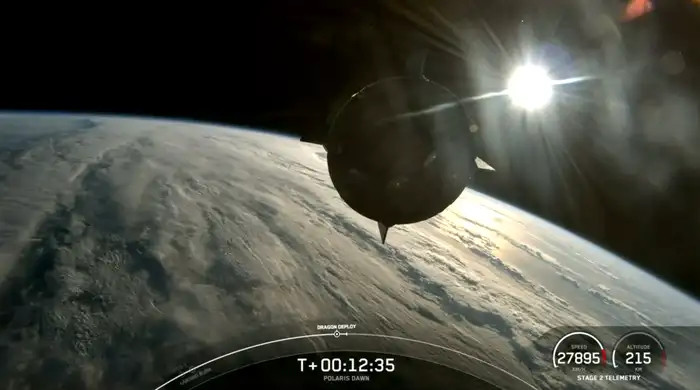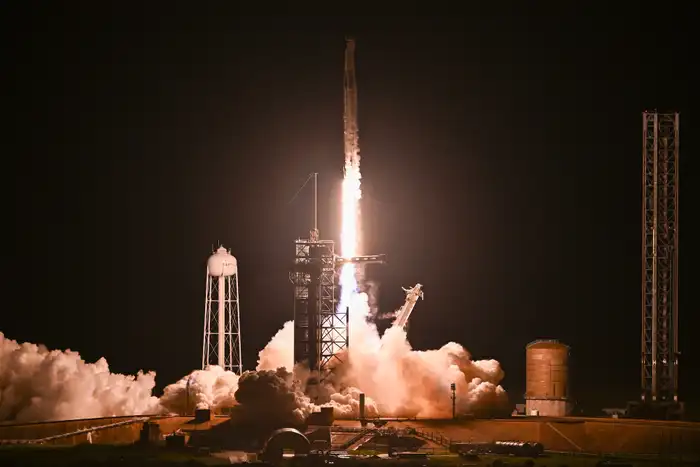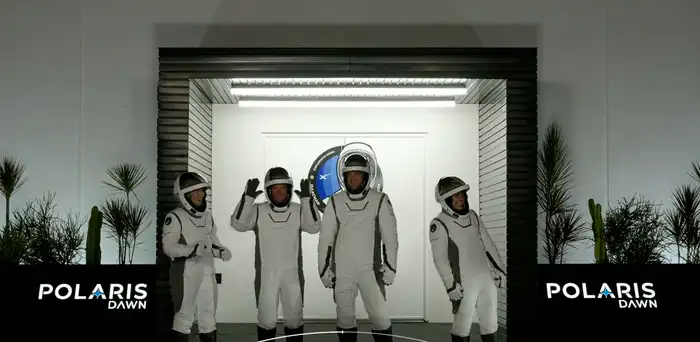SpaceX launches 4 people, including a billionaire, on the most ambitious private human spaceflight yet

The 15-story Falcon 9 rocket launched Tuesday morning.
SpaceX just launched four people on the most ambitious crewed spaceflight since the Apollo era.
The Polaris Dawn mission is a fully private spaceflight, commissioned and funded by a billionaire. None of the four crew members are professional astronauts. But it’s not just space tourism: It’s a key step toward Elon Musk’s plans to build a city on Mars.
The crew includes two SpaceX engineers, Anna Menon and Sarah Gillis, and Scott Poteet, a former US Air Force pilot.
The mission’s benefactor and commander is Jared Isaacman, the billionaire founder of Shift4, a secure-payments company. He previously paid for and flew on the world’s first all-civilian spaceflight, Inspiration4, also through SpaceX.

The Polaris Dawn crew, from left, Anna Menon, Scott Poteet, Jared Isaacman, and Sarah Gillis.
Menon, Gillis, Poteet, and Isaacman climbed aboard their Crew Dragon spaceship on Tuesday morning, atop a 15-story Falcon 9 rocket at a launchpad in Cape Canaveral, Florida. At 5:23 a.m. ET, the Falcon’s engines roared and the rocket climbed toward a pitch-black sky.
Liftoff of Polaris Dawn! pic.twitter.com/hAti2arueX
— SpaceX (@SpaceX) September 10, 2024
“Each of you has trained tirelessly and prepared rigorously for this moment,” Frank Messina, SpaceX’s launch director, told the crew in a livestream.
“Remember that your courage lights the path for future explorers. We trust in your skills, your bravery, and your teamwork to carry out the mission that lies ahead,” he said.
“We are sending you hugs from the ground. Godspeed, Polaris Dawn crew, may you make history and return safely.”
The crew responded: “We appreciate it, and we’re going to get to work now.”

Around 13 minutes after takeoff, the livestream showed incredible views of Earth .
The reusable first stage of the Falcon 9 returned to Earth and landed on SpaceX’s drone ship, called Just Read the Instructions, in the Atlantic Ocean.
Around 13 minutes after takeoff as the first booster stage separated, the livestream showed incredible views of the Earth.
High radiation and the first commercial space walk
Once they settle into orbit, the Polaris Dawn crew has a five-day agenda packed with experiments and a bold space-walk plan. It’s all geared toward paving the way for future human missions to Mars.

A SpaceX Falcon 9 rocket, carrying the crew of the Polaris Dawn Mission, entered space on Tuesday.
For example, any humans traveling to Mars in the future will be exposed to high doses of space radiation for months. Scientists don’t yet fully understand how that would impact the human body.
“If we get to Mars someday, we’d love to be able to come back and be healthy enough to tell people about it,” Isaacman said in a prelaunch briefing on August 19.
The Polaris Dawn crew plans to fly through a belt of intense radiation and monitor their hearts, airways, and eyes along the way. The trip will take them farther from Earth than anyone since the last Apollo astronauts more than 50 years ago.

The Polaris Dawn crew will monitor their eyes as they fly through space.
Future Mars-bound crews might also need to repair their spaceships on the monthslong journey to the red planet.
That’s why the crew is also set to conduct the first commercial space walk ever on day three of the mission, cracking open their Crew Dragon spaceship and exposing its entire interior to the vacuum of space. They’re carrying new SpaceX spacesuits for the operation.

Polaris Dawn crew Anna Menon, Scott Poteet, Jared Isaacman, and Sarah Gillis.
Spacewalks — or “extravehicular activities (EVAs),” as they’re known in the industry — are always risky. But having a spacesuit that works in the vacuum of space is “critical” for the path to Mars, Abhi Tripathi, a former Dragon mission director at SpaceX, said.
“So I think this is a very calculated risk. I think of it as a stepping stone more than a risk, where they’re not going completely out there and doing something different,” Tripathi, who now directs mission operations at UC Berkeley’s Space Sciences Laboratory, told B-17. “They’re adding on capabilities, they’re layering on capabilities.”
More missions to come, including Starship’s first crew
This is just the first mission of an entire Polaris program designed to layer on capabilities.
SpaceX and Isaacman haven’t announced details for the second mission yet, but the third mission is slated to be Starship’s first crewed flight.
That’s the mega-rocket as tall as the Statue of Liberty that SpaceX has been developing in Texas and that flew to space and back for the first time this year.
Starship is the vehicle that’s supposed to bring people and provisions to Musk’s planned city on Mars.
“I think SpaceX has been very clear to everyone what their future holds. They want to build a settlement on Mars,” Tripathi said. “That’s the whole reason the company exists.”






